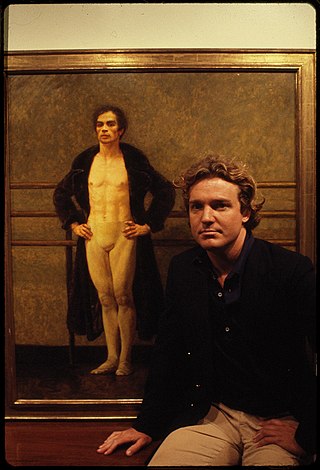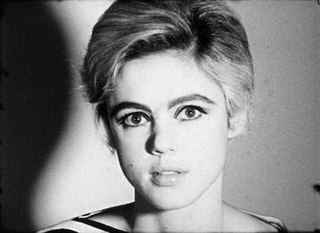Analysis
Andy Warhol made Self-portrait a few months before his death, which was in February 1987. [1]
It uses a Polaroid photograph of him, with the material of acrylic polymer paint and silk screen printing [2] to produce a camouflage pattern over the face surrounded by black.
The Metropolitan Museum of Art describes the image: "Warhol appears as a haunting, disembodied mask. His head floats in a dark black void and his face and hair are ghostly pale, covered in a militaristic camouflage pattern of green, gray, and black." [1]
There is a contrast between the impersonality of the camouflage pattern, which hints at danger, and the personality of the portrait tradition, where there is direct contact with the viewer, although in this case with a protective illusory covering. [2] The ambiguous uses of camouflage—drawing attention when a fashionable look and doing the opposite in military use—fascinated Warhol. [2]
A version in the Philadelphia Museum of Art uses pink and magenta on the same black background. [2] Another version similar to the one kept at the Philadelphia Museum of Art is part of the National Gallery of Victoria's modern art collection.

Andy Warhol was an American visual artist, film director and producer. A leading figure in the pop art movement, Warhol is considered one the most important artists of the second half of the 20th century. His works explore the relationship between artistic expression, advertising, and celebrity culture that flourished by the 1960s, and span a variety of media, including painting, sculpture, photography, and filmmaking. Some of his best-known works include the silkscreen paintings Campbell's Soup Cans (1962) and Marilyn Diptych (1962), the experimental film Chelsea Girls (1966), the multimedia events known as the Exploding Plastic Inevitable (1966–67), and the erotic film Blue Movie (1969) that started the "Golden Age of Porn".

Camouflage is the use of any combination of materials, coloration, or illumination for concealment, either by making animals or objects hard to see, or by disguising them as something else. Examples include the leopard's spotted coat, the battledress of a modern soldier, and the leaf-mimic katydid's wings. A third approach, motion dazzle, confuses the observer with a conspicuous pattern, making the object visible but momentarily harder to locate. The majority of camouflage methods aim for crypsis, often through a general resemblance to the background, high contrast disruptive coloration, eliminating shadow, and countershading. In the open ocean, where there is no background, the principal methods of camouflage are transparencying, silveringing, and countershading, while the ability to produce light is among other things used for counter-illumination on the undersides of cephalopods such as squid. Some animals, such as chameleons and octopuses, are capable of actively changing their skin pattern and colors, whether for camouflage or for signalling. It is possible that some plants use camouflage to evade being eaten by herbivores.

Marisol Escobar, otherwise known simply as Marisol, was a Venezuelan-American sculptor born in Paris, who lived and worked in New York City. She became world-famous in the mid-1960s, but lapsed into relative obscurity within a decade. She continued to create her artworks and returned to the limelight in the early 21st century, capped by a 2014 major retrospective show organized by the Memphis Brooks Museum of Art. The largest retrospective of Marisol's artwork, Marisol: A Retrospective has been organized by the Buffalo AKG Art Museum and curated by Cathleen Chaffee for these museums: the Montreal Museum of Fine Arts, the Toledo Museum of Art, the Buffalo AKG Art Museum, and the Dallas Museum of Art . Although it is supplemented by loans from international museums and private collections, the exhibition draws largely on artwork and archival material Marisol left to the Buffalo AKG Art Museum as a bequest upon her death.

James Browning Wyeth is an American realist painter, son of Andrew Wyeth, and grandson of N.C. Wyeth. He was raised in Chadds Ford Township, Pennsylvania, and is artistic heir to the Brandywine School tradition — painters who worked in the rural Brandywine River area of Delaware and Pennsylvania, portraying its people, animals, and landscape.
Blow Job is a 1964 American silent film directed by Andy Warhol. It depicts the face of an uncredited DeVeren Bookwalter as he apparently receives fellatio from an unseen partner. While shot at 24 frames per second, Warhol specified that it should be projected at 16 frames per second, slowing it down by a third.

Portrait painting is a genre in painting, where the intent is to represent a specific human subject. The term 'portrait painting' can also describe the actual painted portrait. Portraitists may create their work by commission, for public and private persons, or they may be inspired by admiration or affection for the subject. Portraits often serve as important state and family records, as well as remembrances.

Military camouflage is the use of camouflage by an armed force to protect personnel and equipment from observation by enemy forces. In practice, this means applying colour and materials to military equipment of all kinds, including vehicles, ships, aircraft, gun positions and battledress, either to conceal it from observation (crypsis), or to make it appear as something else (mimicry). The French slang word camouflage came into common English usage during World War I when the concept of visual deception developed into an essential part of modern military tactics. In that war, long-range artillery and observation from the air combined to expand the field of fire, and camouflage was widely used to decrease the danger of being targeted or enable surprise. As such, military camouflage is a form of military deception in addition to cultural functions such as political identification.

The Screen Tests are a series of short, silent, black-and-white film portraits by Andy Warhol, made between 1964 and 1966, generally showing their subjects from the neck up against plain backdrops. The Screen Tests, of which 472 survive, depict a wide range of figures, many of them part of the mid-1960s downtown New York cultural scene. Under Warhol's direction, subjects of the Screen Tests attempted to sit motionless for around three minutes while being filmed, with the resulting movies projected in slow motion. The films represent a new kind of portraiture—a slowly moving, nearly still image of a person. Warhol's Screen Tests connect on one hand with the artist's other work in film, which emphasized stillness and duration (for example, Sleep and Empire, and on the other hand with his focus after the mid-1960s on documenting his celebrity milieu in paintings and other works.

Campbell's Soup Cans is a work of art produced between November 1961 and June 1962 by the American artist Andy Warhol. It consists of thirty-two canvases, each measuring 20 inches (51 cm) in height × 16 inches (41 cm) in width and each consisting of a painting of a Campbell's Soup can—one of each of the canned soup varieties the company offered at the time. The works were Warhol's hand-painted depictions of printed imagery deriving from commercial products and popular culture and belong to the pop art movement.

Washington at Princeton is a 1779 painting by Charles Willson Peale, showing George Washington after the Battle of Princeton. The original was commissioned by the Supreme Executive Council of Pennsylvania for its council chamber in Independence Hall in Philadelphia. Peale made eight copies of the painting. The original, now owned by the Pennsylvania Academy of the Fine Arts, was completed in early 1779, when Washington sat for Peale in Philadelphia.

Shot Marilyns is a series of silkscreen paintings produced in 1964 by Andy Warhol, each canvas measuring 40 inches square, and each a portrait of Marilyn Monroe.
Rob Pruitt is an American post-conceptual artist. Working primarily in painting, installation, and sculpture, he does not have a single style or medium. He considers his work to be intensely personal and biographical.

Orange Prince is a painting by American artist Andy Warhol of Prince, the American singer, songwriter, record producer, multi-instrumentalist, actor, and director. The painting is one of twelve silkscreen portraits on canvas of Prince created by Warhol in 1984, based on an original photograph provided to Warhol by Vanity Fair. The photograph was taken by Lynn Goldsmith. These paintings and four additional works on paper are collectively known as the Prince Series. Each painting is unique and can be distinguished by colour.

The Marilyn Monroe portfolio is a portfolio or series of ten 36×36 inch silkscreened prints on paper by the pop artist Andy Warhol, first made in 1967, all showing the same image of the 1950s film star Marilyn Monroe but all in different, mostly very bright, colors. They were made five years after her death in 1962. The original image was taken by Warhol from a promotional still by Gene Kornman for Monroe's film Niagara (1953).

Reigning Queens is a 1985 series of silkscreen portraits by American artist Andy Warhol. The screen prints were presented as a portfolio of sixteen; four prints each of the four queens regnant. The subjects were Queen Elizabeth II of the United Kingdom and the other Commonwealth realms, Queen Beatrix of the Netherlands, Queen Ntfombi Twala of Swaziland and Queen Margrethe II of Denmark.
Ten Portraits of Jews of the Twentieth Century is a 1980 series of ten paintings by Andy Warhol. Following their initial exhibition, the paintings were exhibited at synagogues and Jewish institutions across the United States.

Vote McGovern, also known as Vote McGovern, 1972, is a 1972 colored lithograph by Andy Warhol. He produced it in support of George McGovern's 1972 presidential campaign. The print doesn't depict McGovern, but instead is a depiction of a photograph of then-President of the United States Richard Nixon with his face dyed green and blue, and with his jacket and tie dyed pink and red, respectively. Nixon was the Republican and McGovern the Democrats' candidate in the 1972 United States presidential election.

Dos Cabezas is a painting created by American artist Jean-Michel Basquiat in 1982. The double portrait resulted from Basquiat's first formal meeting with his idol, American pop artist Andy Warhol.

Jean-Michel Basquiat is a painting created by American artist Andy Warhol in 1982. Warhol made multiple silkscreen portraits of artist Jean-Michel Basquiat using his "piss paintings."

Gold Marilyn Monroe is a screenprint painting by Andy Warhol based on a photograph of the actress Marilyn Monroe's face centered on a large gold-painted canvas. Warhol used silkscreen ink on synthetic polymer paint on canvas. It was completed in 1962, the same year as Monroe's death. The image of Monroe is a direct copy of a close-up photograph, a publicity still from her 1953 film Niagara.
















